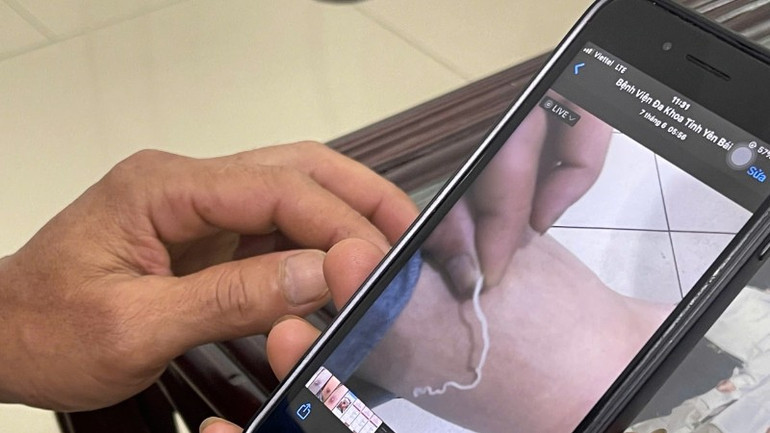After noticing an itchy, swollen spot on his leg that later began discharging pus, 43-year-old Nguyen Xuan Q. from An Thinh commune (Van Yen district, Yen Bai province) was horrified to pull a parasite nearly 70cm long from the wound. It wasn’t until he extracted worms on two separate occasions that he finally sought help at a central hospital.
At Dang Van Ngu Hospital (National Institute of Malariology, Parasitology and Entomology), where he was examined for suspected parasitic infection, Mr. Q. described feeling firm, noodle-like bumps under his skin.
“I’ve pulled worms out at home a few times. I visited a provincial hospital but wasn’t confident in the results, so I came here hoping for definitive treatment,” he said.
Shocking self-extraction of a 70cm worm

Mr. Q. recalls extracting a worm himself in mid-June 2025 at Yen Bai Provincial General Hospital
Raised in a mountainous region, Mr. Q. had long consumed raw vegetables, uncooked dishes, and spring water - never suspecting these habits might expose him to parasites.
While working as a construction laborer in Hanoi, he first noticed an itchy patch on his leg. It wasn’t painful or accompanied by fever, but it swelled and hardened into a lump. Thinking it was just a boil, he waited. Eventually, when the swelling softened and pus appeared, he squeezed it and was startled to extract a long thread-like organism.
“At one point, I pulled out a flat worm, thinking it was a tapeworm. Another time, I removed a white worm from near my knee that stretched about 70cm before snapping,” Mr. Q. recounted. He had heard of similar cases in nearby villages and, after researching online, suspected dragon worm disease. Concerned about not removing the entire parasite, he visited local hospitals and was referred to the provincial level, where another worm was extracted.
“One time, I managed to pull out the whole worm - its head was still wriggling,” he recalled.
Ultrasound scans at Dang Van Ngu Hospital confirmed the presence of dragon worm beneath his skin. He was prescribed medication and given detailed guidance on how to manage the condition. “If you extract any more worms, call us immediately so we can collect samples for epidemiological research,” Dr. Tran Huy Tho advised.
No specific treatment for dragon worm infection
Dr. Tran Huy Tho, Deputy Director of Dang Van Ngu Hospital, explained that Vietnam currently lacks a specific treatment protocol for dragon worm infections. Treatment focuses on removing the worm and wound care.
The recommended method is to keep the wound away from communal water sources. The site should be cleaned, then soaked in water using a basin or similar container to encourage the worm to contract and release larvae. The worm is then slowly wound around gauze or a stick to maintain tension and coax it out. This process may take days or weeks, as the worm can be over a meter long. Extraction must be done slowly to avoid breaking it.
Doctors typically prescribe local antibiotics to prevent secondary bacterial infection, and anti-inflammatory medications such as aspirin, ibuprofen, or alphachymotrypsin until the entire worm is removed.
According to Dr. Tho, the suspected source of infection is drinking spring water containing water fleas that carry the parasite. Symptoms are nonspecific and may include dizziness, nausea, diarrhea, localized redness, numbness, and joint pain. In some cases, the worm may calcify and cause abscesses.
Dragon worm: A newly re-emerging disease in Vietnam
Vietnam was certified free of dracunculiasis (dragon worm disease) by the WHO in 1998, with no reported cases of Dracunculus sp. until April 2020, when the first case was discovered in Phuc Ninh commune (Yen Binh district, Yen Bai province). According to the National Institute of Malariology, 25 cases were reported between May 2020 and November 2024.
Dr. Tho confirmed that from 2020 to 2025, Vietnam has recorded nearly 30 cases across 19 communes in 11 districts spanning five provinces: Hoa Binh, Lao Cai, Phu Tho, Thanh Hoa, and Yen Bai.
As the disease has no vaccine or definitive treatment, Dr. Tho urges medical facilities to strengthen surveillance to identify human and animal infections (including dogs and cats) within 24 hours of worm emergence. This helps prevent complications like wound infection or sepsis.
Preventive measures include ensuring safe drinking water, preventing infected individuals and animals from entering water sources, and applying larvicide (temephos) to control water fleas. Public health campaigns are needed to promote safe food and water consumption and raise awareness of parasitic diseases.
Dr. Tho emphasized the importance of consulting appropriate specialists for accurate diagnosis and timely treatment. While the disease is not fatal, it can cause severe discomfort and pain in patients.
PV